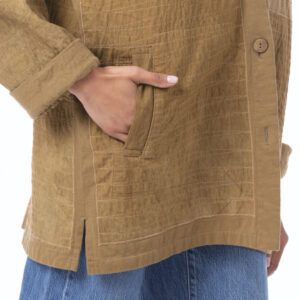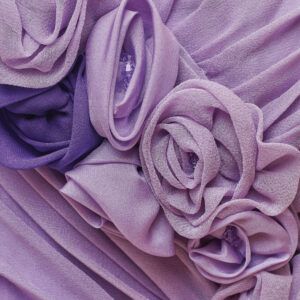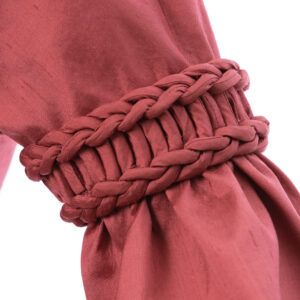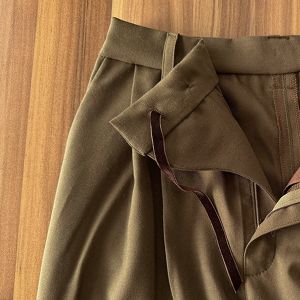I’m using a size 9 – smallest made for my machine?- regular needle on my ancient and reliable Singer, to sew on a very fine “Swiss cotton” voile. Luckily I experimented sewing on a scrap of fabric before getting into the garment, because my stitching is leaving white tracks in the work. The fabric is woven of navy and white threads in a sheer houndstooth pattern. The tracks are not evident when I sew in a straight seam on the cross-wise grain of the fabric, but are unacceptably obvious on lengthwise-grain seams. I’ve tried adjusting the tension, using different threads, with no noticeable difference. Is there a smaller needle I can use, or a different type? What can I do?
Note: I have not had any trouble with pins leaving these tracks, and when I forgot to thread the needle once during my experiment with different threads, the needle didn’t leave marks either. It sounds like the thread, doesn’t it? I have tried the Mettler silk-finish cotton thread and the Mettler polyester thread, thinking they were finer than ordinary Coats and Clark Dual Purpose. That’s all that’s available to me except perhaps serger thread. Can serger threads be used on a regular sewing machine for straight seaming?
Joan
Edited 5/12/2005 2:14 am ET by JoanSch
Edited 5/12/2005 2:23 am ET by JoanSch
Edited 5/12/2005 2:29 am ET by JoanSch



























Replies
What TYPE of needle are you using? If you are using a universal needle, try a "microtex" or "Sharp". These are designed with a different type of point for sewing on silk and heirloom sewing. There is a good on-line article on the Threads web-site (http://www.threads.com) about choosing the correct needle including a chart describing the various types. Just type "needles" into the search window for fiber arts.
I'm just using a standard Singer needle. I hope I can find one of the ones you've mentioned. Do you think it really is the needle, since sewing without thread doesn't leave the marks?
Thanks for your suggestion.
I use cotton 60 wt. embroidery thread for sewing on fine fabrics. It takes up less room and makes a very fine seam.
Nancy
I've gone looking for the http://www.threads.com web site you mentioned, and got a web site for Prezencia threads, with no search button for fiber arts. Did you mean threadsmagazine.com?Thanks for your help.
Sorry about that! Try this!
http://www.taunton.com/threads/index.asp
You might also try silk thread. Guterman's makes some. It is finer than polyester, often suggested for hand basting when you want to be sure you don't leave tracks after you press and remove your basting. As some others have suggested, make sure your tension is properly balanced and try a slightly longer stitch length.
I'm getting discouraged. Tried the Schmetz Microtex Sharp needles, but couldn't get it smaller than a 70/10. Tried the Schmetz Universal in a 60/8. Tried tissue paper between the presser foot and the fabric. Tried serger thread. Varied stitch length and tension. Tried washing and steaming. Nothing is producing satisfactory results. I'm going to search further for a Sharp in 60/8, and try some cotton embroidery thread and some silk thread, but I have to drive quite a way to get to a Joann's, and I'm complaining, aren't I! Keep your fingers crossed for me. I appreciate all the suggestions.
Edited 5/16/2005 2:57 pm ET by JoanSch
Also, I looked up the needle articles you recommended , and they're great information to have. Thanks for that. Some of the on-line articles were from issues of Threads before I started subscribing, and there's a great "anatomy of the needle" which helps to understand the differences.
what about a ballpoint needle instead?
Is the presser foot leaving the marks? can you lighten up the pressure on it, also, metler makes a 60 weight cotton (embroidery) thread that is much lighter weight, you might try that. what about using a very light weight tear away stabilizer when you sew the seam and then be very careful when you tear it away so as not to distort the seam. good luck
I don't think I can adjust the presser foot pressure on my 1966 Singer, but I'll look into it. I'll also try the stabilizer--thanks for that input.
I'm not convinced that the pressure foot is causing your problem, but adjusting that tension is often important, so it's worth a try. It's often easy to adjust the pressure foot tension on older machines-- just look directly above the needle, at the top of the machine. You should see a type of plunger (perhaps with numbers on it) with a cuff around it, right on top of the case. To reset the pressure, push down on the cuf, which is spring-loaded, until the plunger pops up (this is a good tension for fleece or very stretchy fabrics). Then you can push the plunger down a little at a time until the pressure foot is holding but not pushing too hard on the fabric.If you can't avoid the white marks, is there any way you can incorporate them (and maybe extra stitching) into the design? Often, "mistakes" result in far more interesting garments!
Thank you for your suggestions. Since I finally discovered the pressure adjustment wheel on my machine (!) I've played with the pressure to no avail. I already had the pressure set on the lightest setting, and increasing it increases the distortion. Needle tension adjustments don't solve the problem either.The serger thread I'm using is a slight improvement -- would embroidery thread be better, do you think?Since the needle, unthreaded, doesn't leave a mark, it seems like a thread problem to me, but I'm going to try to find a smaller needle anyway.
If I remember correctly, you said the fabric has a white thread in one direction (warp or weft?) and a navy thread the other? Then it seems the combination of thread and needle are breaking those white fibers and pushing them up through the surface. Or the fabric is shredding the thread as it passes through?You've already tried many more options than I would've had patience to try, but you might have success with other combinations of needles (ball point, wing, even denim needles-- that might separate rather than break the fibers) along with threads of different fibers and weights. At this point, the color of thread is the least important, so check your stash for whatever options you have on hand. I've had luck with the strangest combinations, like invisible thread and a denim needle on a sheer fabric, or silk on an upholstery fabric, so maybe you will, too.What a vexing problem--let us know if you solve it!
With my magnifying glass, it appears the tiny navy weft threads are being squeezed together by the stitches, leaving white warp threads bare in tiny triangles on both sides where the sewing thread enters the fabric. So I think the needle and thread are pushing the navy threads apart. The threads in the fabric are so fine and so closely woven, I almost think I need a thread as small as the weft threads. I think a truly fine thread might help but can't find anything at the Hancock's and Joann's fabric stores that are available to me. The folks at a sewing machine shop I sometimes use tried stitching a scrap of my fabric on their various new machines, and couldn't get better results than I did on mine, but they didn't have fine threads either. I probably should save this fabric for another use or another time when I have time to order threads and needles, but I'm feeling rushed now.Thanks so much for your help. I'll let you know what happens.
Considering all of your attemps so far and with a further discription of the problem have you tried increasing the stitch length? I think that it now sounds like you may be crowding the weft or warp threads together causing this problem. Also try using the ball point needle again and lengthening the stitch.
you also said if I remember correctly that the problem was only when you sewed in one direction (crosswise vs lengthwise) so this will also have a lot to do with it, the direction of the weave of the white fibers, also, the crosswise (weft) threads are looser than the lengthwise (warp) threads. this will also affect the results, the lenghtwise threads are placed on the loom first and are under much higher tension than the weft thread that is woven onto it, thats why woven goods will have greater strech in the crosswise than the lengthwise AND, why fabric will shrink more on the lengthwise grain than the crosswise. That being said, with all the different things you have tried, you may not be able to avoid the problem, as someone else mentioned, have you tried hand sewing it? is there some way you can incorporate this into the garment?
Judy
Thanks to all of you who offered suggestions on this frustrating project. I had to put the project aside 'til now. I'm going to try the hand-stitching. I tried everything else--just about every needle, stitch-length, tension, thread, pressure, available--and it is as Heartfire says, all about the way the fabric is woven. I fell in love with the feel of the fabric, as is my usual weakness, and wasn't prepared for the way it looks when stitched by machine. Next time I have a fabric like this I think I'll test-stitch on a bit of it before cutting. I could have perhaps avoided the problem if I'd cut the fabric on the cross-wise grain, since almost all my stitching was done on the lengthwise, and that's where the problem showed up. - Joan
I still haven't tried the stabilizer, but will do that when I try to find a smaller needle today. Thanks.
Since increasing the pressure makes it worse that indicates that drag from the foot is contributing. You could try a Teflon or roller foot or just putting tissue paper between the foot and fabric. Please do try all these things with scraps.
Sounds like the foot is dragging the fabric enough to displace the dark thread and expose the white ones. Try a teflon foot, try steaming or washing the fabric to get the threads back into position. Try putting tissue paper between the fabric and the foot.
You might even be able to realign the threads with some gentle tugging or rubbing. It's great you checked this out with scraps first and you can try anything you or anyone else thinks of to try and remedy this as long as you have scraps.
The foot dragging the fabric enough to distort the threads -- that sounds like what is happening. It's like the navy threads just get pulled away, exposing the white on either side of the place where the needle enters the fabric, leaving little tiny white dots which look like needle-tracks, but aren't. I can try the tissue and the steaming -- thanks so much. Rubbing along the seam gently with my fingernail does seem to help a little -- so I'm hopeful about the steaming. I'll let you all know what, if anything, works.
What color bobbin thread are you using? Those white dots could be the bobbin half of the stitch peeking through.
There is a smaller needle out there. I have used a size 8, and like the others have said it could be the thread showing up from the bobbin as well. Be sure you are using a "sharp" as mentioned before.
I've been away for the weekend, so couldn't try suggestions until yesterday afternoon. I am sewing with navy serger thread in the bobbin and on top of the machine, instead of the Mettler "silk-finish" cotton thread I was using before. The white spots that show up are on both sides of the needle penetration points, so it is a distortion, or a pulling away of the navy woven threads, revealing white threads, that is occurring.I discovered I do have a pressure control for the presser foot, but it is already set on the lightest pressure. Increasing the pressure results in more noticeable white spots along the seam. I have noticed that sewing very slowly leaves a better-looking seam than sewing more quickly -- why would that be so?Steaming doesn't seem to repair the damage.I'm going to search for a smaller, size 8 sharp needle today. Wish me luck!
Just a couple of ideas:
1) As has been suggested, you do need a fine "sharp" needle. Those things are marvelous.
2) Sometimes, with very fine fabrics, you have to use very fine thread. You can try cotton machine embroidery thread (not rayon), made by Gutermann (and possibly Coats and Clarks--not sure about that last one). Some people say you can also use serger thread, which is finer than regular thread, but I haven't personally tried this.
When machine sewing fails I hand sew. Hand sewing doesn't seem to be everyone's favorite type of sewing but I really like it. When a fabric is difficult to work on the machine, beaded chiffon for example, I find it much easier to start in with my hand sewing needle than to deal with the preparations it might take to get the fabric ready and working under the machine needle. Perhaps you have tried some hand sewing to see if that has the same effect on the white threads?
Yes, I probably should only hand-sew this fabric. Hand stitches do not distort the weave of the fabric the way the machine stitches do, even using the threads I already have available. I don't think I have time to do this garment by hand, but if I did, would you use a tiny back-stitch or what? I haven't planned any top-stitching or exposed stitching, but thought I would use french seams on this sheer fabric.Thanks so much for your interest and help.
For the french seams I think a small running stitch would work well. In places where you need some give and/or strength, such as curves, then a back stitch. It doesn't take much to join a finely woven fabric at a seam. If you think about it the machine seam really is overkill on let's say chiffon. That is an awful lot of thread top and botton and then there is the all the yanking and tautness by the way a machine stitches. But it works, for the most part.Hand sewing does seem to take a lot of time. A long seam can feel endless when you know how quickly it can run on a machine! But sometimes it isn't any slower than machine sewing. If your fabric has a mind of its own it can often be managed much more easily on a table with your needle that be made to feed cooperatively under the presser foot. All the time spent wrestling and prepping the fabric to get it on the machine for one seam can add up to a couple of seams by hand.Also, a hand sewing project can be like a knitting project in that it can be portable and you take it socializing with you. With like minded people, I suppose :-)Good luck with you project and enjoy.
This post is archived.